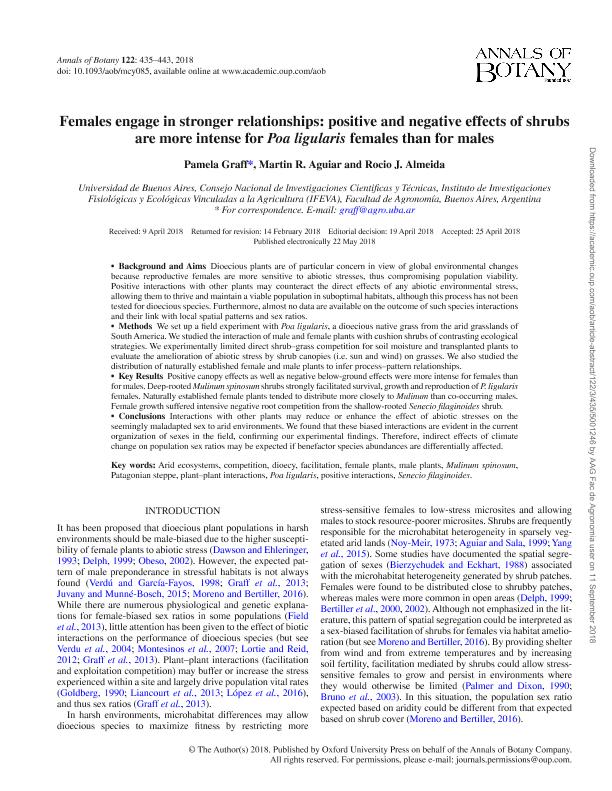Mostrar el registro sencillo del ítem
dc.contributor.author
Graff, Barbara Pamela

dc.contributor.author
Aguiar, Martin Roberto

dc.contributor.author
Almeida, Rocio Jezabel

dc.date.available
2020-01-08T19:51:13Z
dc.date.issued
2018-09
dc.identifier.citation
Graff, Barbara Pamela; Aguiar, Martin Roberto; Almeida, Rocio Jezabel; Females engage in stronger relationships: positive and negative effects of shrubs are more intense for Poa ligularis females than for males; Oxford University Press; Annals of Botany; 122; 3; 9-2018; 435-443
dc.identifier.issn
0305-7364
dc.identifier.uri
http://hdl.handle.net/11336/93993
dc.description.abstract
Background and Aims Dioecious plants are of particular concern in view of global environmental changes because reproductive females are more sensitive to abiotic stresses, thus compromising population viability. Positive interactions with other plants may counteract the direct effects of any abiotic environmental stress, allowing them to thrive and maintain a viable population in suboptimal habitats, although this process has not been tested for dioecious species. Furthermore, almost no data are available on the outcome of such species interactions and their link with local spatial patterns and sex ratios. Methods We set up a field experiment with Poa ligularis, a dioecious native grass from the arid grasslands of South America. We studied the interaction of male and female plants with cushion shrubs of contrasting ecological strategies. We experimentally limited direct shrub–grass competition for soil moisture and transplanted plants to evaluate the amelioration of abiotic stress by shrub canopies (i.e. sun and wind) on grasses. We also studied the distribution of naturally established female and male plants to infer process–pattern relationships. Key Results Positive canopy effects as well as negative below-ground effects were more intense for females than for males. Deep-rooted Mulinum spinosum shrubs strongly facilitated survival, growth and reproduction of P. ligularis females. Naturally established female plants tended to distribute more closely to Mulinum than co-occurring males. Female growth suffered intensive negative root competition from the shallow-rooted Senecio filaginoides shrub. Conclusions Interactions with other plants may reduce or enhance the effect of abiotic stresses on the seemingly maladapted sex to arid environments. We found that these biased interactions are evident in the current organization of sexes in the field, confirming our experimental findings. Therefore, indirect effects of climate change on population sex ratios may be expected if benefactor species abundances are differentially affected.
dc.format
application/pdf
dc.language.iso
eng
dc.publisher
Oxford University Press

dc.rights
info:eu-repo/semantics/openAccess
dc.rights.uri
https://creativecommons.org/licenses/by-nc-sa/2.5/ar/
dc.subject
ARID ECOSYSTEMS
dc.subject
COMPETITION
dc.subject
DIOECY
dc.subject
FACILITATION
dc.subject
FEMALE PLANTS
dc.subject
MALE PLANTS
dc.subject
MULINUM SPINOSUM
dc.subject
PATAGONIAN STEPPE
dc.subject
PLANT-PLANT INTERACTIONS
dc.subject
POA LIGULARIS
dc.subject
POSITIVE INTERACTIONS
dc.subject
SENECIO FILAGINOIDES
dc.subject.classification
Ciencias de las Plantas, Botánica

dc.subject.classification
Ciencias Biológicas

dc.subject.classification
CIENCIAS NATURALES Y EXACTAS

dc.subject.classification
Ecología

dc.subject.classification
Ciencias Biológicas

dc.subject.classification
CIENCIAS NATURALES Y EXACTAS

dc.title
Females engage in stronger relationships: positive and negative effects of shrubs are more intense for Poa ligularis females than for males
dc.type
info:eu-repo/semantics/article
dc.type
info:ar-repo/semantics/artículo
dc.type
info:eu-repo/semantics/publishedVersion
dc.date.updated
2019-10-23T21:15:41Z
dc.journal.volume
122
dc.journal.number
3
dc.journal.pagination
435-443
dc.journal.pais
Reino Unido

dc.journal.ciudad
Oxford
dc.description.fil
Fil: Graff, Barbara Pamela. Consejo Nacional de Investigaciones Científicas y Técnicas. Oficina de Coordinación Administrativa Parque Centenario. Instituto de Investigaciones Fisiológicas y Ecológicas Vinculadas a la Agricultura. Universidad de Buenos Aires. Facultad de Agronomía. Instituto de Investigaciones Fisiológicas y Ecológicas Vinculadas a la Agricultura; Argentina
dc.description.fil
Fil: Aguiar, Martin Roberto. Consejo Nacional de Investigaciones Científicas y Técnicas. Oficina de Coordinación Administrativa Parque Centenario. Instituto de Investigaciones Fisiológicas y Ecológicas Vinculadas a la Agricultura. Universidad de Buenos Aires. Facultad de Agronomía. Instituto de Investigaciones Fisiológicas y Ecológicas Vinculadas a la Agricultura; Argentina
dc.description.fil
Fil: Almeida, Rocio Jezabel. Consejo Nacional de Investigaciones Científicas y Técnicas. Oficina de Coordinación Administrativa Parque Centenario. Instituto de Investigaciones Fisiológicas y Ecológicas Vinculadas a la Agricultura. Universidad de Buenos Aires. Facultad de Agronomía. Instituto de Investigaciones Fisiológicas y Ecológicas Vinculadas a la Agricultura; Argentina
dc.journal.title
Annals of Botany

dc.relation.alternativeid
info:eu-repo/semantics/altIdentifier/url/https://academic.oup.com/aob/article-abstract/122/3/435/5001246
dc.relation.alternativeid
info:eu-repo/semantics/altIdentifier/doi/http://dx.doi.org/10.1093/aob/mcy085
Archivos asociados
